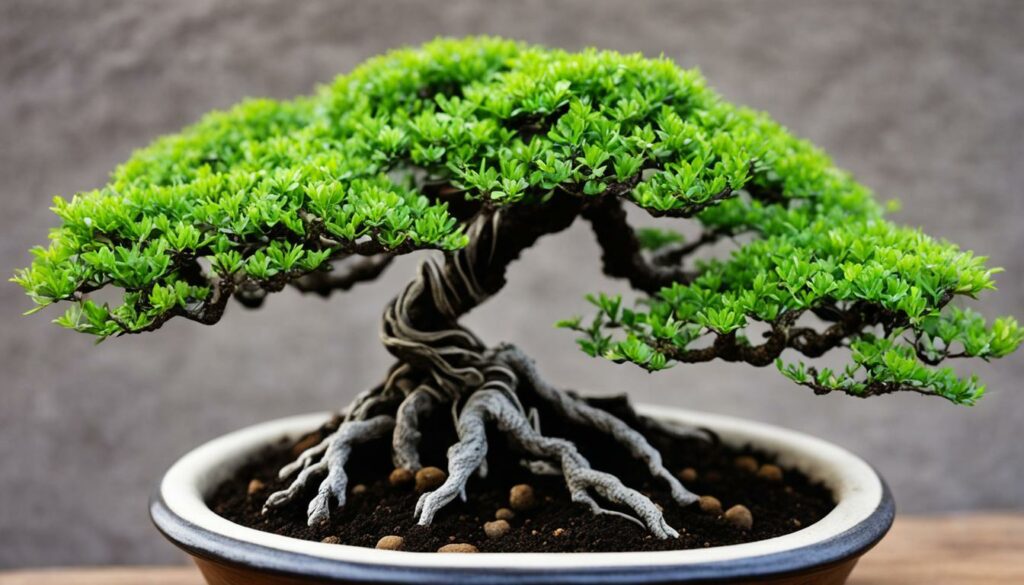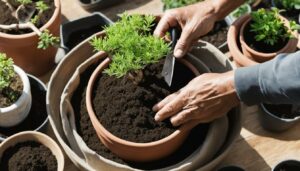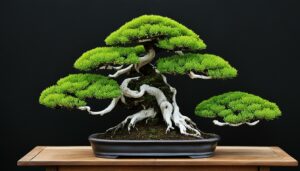Are you looking for a serene addition to your household or office space? Bonsai cultivation is a popular hobby that can bring natural beauty and tranquillity into your surroundings. However, buying the right bonsai can be an overwhelming decision, as there are many factors to consider, such as species, size, and care requirements.
In this comprehensive buyer’s guide, we’ll walk you through everything you need to know to make an informed bonsai purchase. Whether you want to start with a beginner-friendly starter bonsai or expand your existing collection, this guide will provide valuable insights and buying tips to help you select the perfect bonsai tree for your lifestyle and space.
Key Takeaways
- Choosing the right bonsai requires considering your lifestyle, available space, and preferences.
- There are various bonsai species, each with unique characteristics and maintenance requirements.
- Bonsai cultivation is a long-term commitment that requires patience and persistence.
- Bonsai care involves essential aspects such as watering, fertilization, pruning, and repotting.
- Local nurseries and online marketplaces offer options for purchasing bonsai trees, each with its advantages and considerations.
Understanding Bonsai: A Brief Introduction
Before you purchase a bonsai tree, it’s essential to understand the art of bonsai cultivation. Bonsai trees are not simply miniature versions of regular trees; they are carefully pruned and styled to create a harmonious and serene aesthetic.
The origins of bonsai can be traced back to China and Japan, where it was initially practiced as a hobby by the elite class. As bonsai cultivation gained popularity, it evolved into an art form, with skilled practitioners manipulating the trees to create intricate shapes and designs.
The key principle of bonsai cultivation is to create a tree that is in harmony with its surroundings. This involves careful consideration of the tree’s shape, size, and placement. By sculpting the tree’s branches, roots, and foliage, bonsai artists aim to create a sense of balance and tranquility.
To achieve this, bonsai cultivation requires a great deal of skill and patience. A bonsai tree can take years or even decades to reach its full potential, and the process of shaping and pruning requires careful attention to detail.
The Art of Shaping Miniature Trees
Bonsai trees are shaped using a variety of techniques, including wiring, pruning, and grafting. Wiring involves wrapping the tree’s branches with wire to guide their growth in a specific direction. Pruning involves removing unwanted branches or leaves to create the desired shape. Grafting involves merging two different trees to create a unique design.
Each of these techniques requires knowledge and skill, and mastery of these techniques can take years of practice. However, with patience and dedication, anyone can learn to create beautiful bonsai trees.
Assessing Your Lifestyle and Space
Choosing the right bonsai tree that matches your lifestyle and space is important to ensure a harmonious match. Some of the crucial factors that need to be taken into account during the selection process are:
1. Sunlight Exposure
Bonsai trees have different sunlight requirements depending on the species. Some species, such as the jade plant, require bright but indirect sunlight, while others such as the ficus require full sunlight. Assess the amount and direction of sunlight in your house or apartment to determine which species would be the best fit.
2. Temperature
Bonsai trees also have different temperature requirements. Some species, such as the juniper, prefer cooler temperatures while others such as the Chinese elm are tolerant to a wide range of temperatures. Ensure that the species you choose thrives in the temperature range of your living space.
3. Available Space
Bonsai trees range in size from small varieties that can fit on a windowsill to larger ones that require a spacious area. Measure the available space in your home or apartment and choose a bonsai tree that fits the space and is visually appealing.
By assessing your lifestyle and space, you can select the perfect bonsai tree that thrives in your environment and brings you joy.
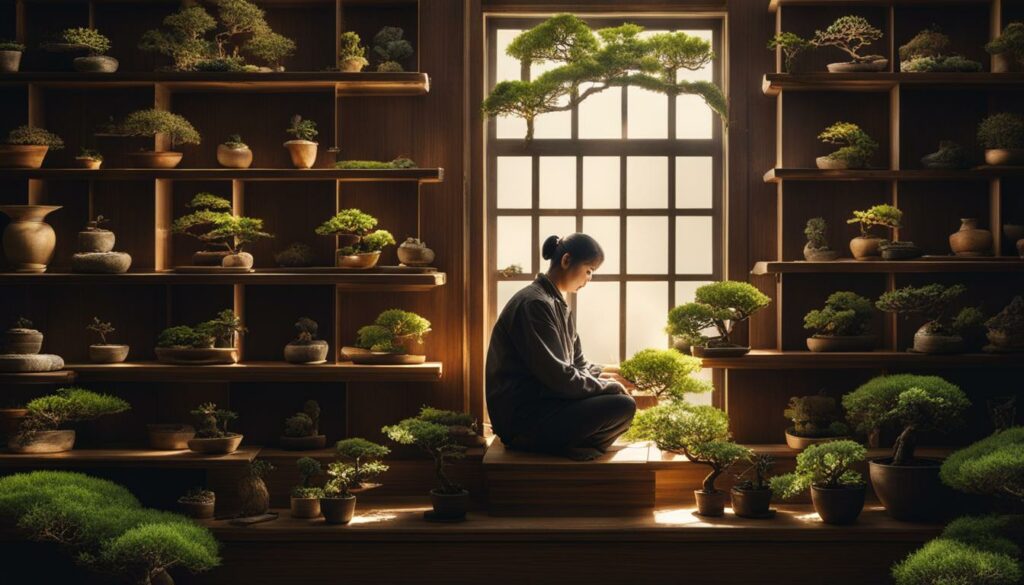
Types of Bonsai Trees
When selecting your bonsai tree, it’s crucial to consider which species will meet your preferences and maintenance capabilities. From traditional Japanese varieties to tropical options, there’s a diverse range of species to choose from. Let’s explore some popular types of bonsai trees:
| Bonsai Tree Species | Characteristics |
|---|---|
| Juniper | One of the most popular bonsai species; hardy and low-maintenance; adaptable to different styles of shaping; available in various sizes |
| Pine | Distinctive and elegant appearance; soft needles and attractive bark; requires full sunlight and well-draining soil; adaptable to various pruning techniques |
| Ficus | Popular tropical species; lush foliage and aerial roots; suitable for indoor and outdoor cultivation, but requires consistent warmth; ideal for beginners |
| Jade | Succulent species; resilient and long-living; requires bright, indirect sunlight; thrives in well-drained soil; suitable for bonsai styling |
There are many other varieties of bonsai trees available, each with their own unique characteristics and cultivation requirements. When selecting your bonsai tree, consider factors such as your location, climate, and experience level to ensure a harmonious match.
To learn more about bonsai selection, browse our Bonsai Cultivation Buying Bonsai guide.
Bonsai Styling Techniques
Once you have selected the suitable bonsai species for your lifestyle and space, it’s time to explore the different techniques for shaping your tree into a unique work of art. By understanding how these techniques influence the appearance and character of the bonsai, you can unleash your creative potential and create a visually striking tree.
The following are some popular bonsai styling techniques:
| Technique | Description |
|---|---|
| Formal Upright | Characterized by a straight, upward trunk with a triangular shape, this style portrays the traditional and formal look of a tree. The branches become shorter and thinner toward the top of the tree. |
| Cascade | Inspired by the appearance of trees growing on the edge of cliffs, the cascade style features a trunk that cascades downwards, creating a flowing waterfall-like effect. The branches grow horizontally and balance the weight of the tree. |
| Windswept | This style depicts a tree that has grown on a windy coast, with its trunk and branches bent by the force of the wind. Branches grow on one side of the tree, while the other side is barren. |
Keep in mind that each bonsai species may suit certain styling techniques better, so it’s important to assess the characteristics of your tree and select a suitable style. Whether you opt for a traditional and elegant formal upright or a dynamic and free-spirited windswept style, spend time observing your tree and experimenting to achieve the desired effect.
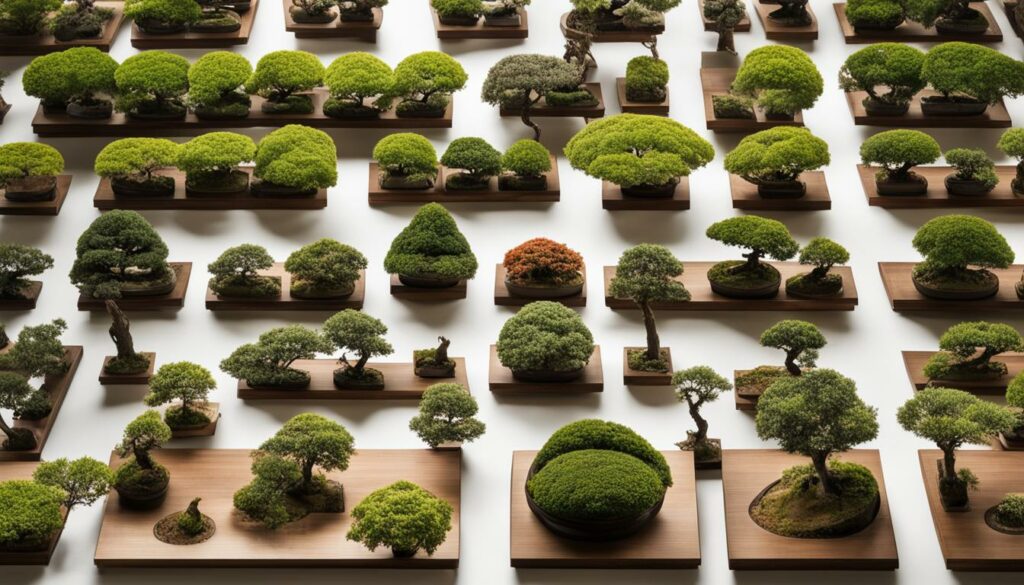
Choosing the Right Bonsai Size
When it comes to bonsai, choosing the right size is crucial. The size determines the level of maintenance and the visual impact of your tree. Here are some buying tips to help you choose the right bonsai size:
Evaluate Your Space and Skills
Assess your available space to determine the appropriate size of your bonsai tree. Consider factors like the size of your home or office, the amount of natural light in the area, and the temperature of the environment. Also, evaluate your gardening skills and the time you can dedicate to bonsai care. Select a size that suits your experience level and maintenance capabilities.
Choose Based on Tree Age
Bonsai trees are classified based on their age and size, ranging from young seedlings to mature, fully-grown trees. Consider the age of the tree when deciding on the size. Younger trees require less maintenance and are easier to shape, making them an excellent choice for beginners. More mature trees, on the other hand, require more experience and time for pruning and maintenance.
Find the Right Balance
When choosing the size of your bonsai tree, it’s essential to find the right balance between the tree’s visual impact and maintenance requirements. A larger tree may make a more significant statement, but it will require more time and effort to care for. A smaller tree may be easier to maintain, but it may not have the same visual impact as a larger one. Find a size that strikes the perfect balance for your needs.
Local Bonsai Nurseries and Online Marketplaces
Once you have assessed your requirements and preferences, it’s time to explore the options available for purchasing bonsai trees. Broadly speaking, you can buy bonsai trees through local nurseries or online marketplaces, each with its advantages and considerations.
Local Bonsai Nurseries
Visiting local nurseries is an excellent way to ensure a personalized experience, allowing you to see and experience the bonsai trees in person. You can observe their size, shape, texture, and overall health, which can influence your purchasing decision. Moreover, you can consult the nursery staff for expert advice on choosing a bonsai tree that aligns with your preferences and skills.
Keep in mind that local nurseries may have a limited selection of bonsai trees, and their prices may be higher than online marketplaces due to overhead costs. However, supporting local businesses can provide a sense of community and satisfaction.
Online Marketplaces
Online marketplaces provide a wide variety of bonsai trees from around the world, allowing you to compare and choose from an extensive selection. Additionally, you can read reviews and ratings from other customers, helping you make an informed decision. Furthermore, online marketplaces often offer competitive prices and discounts, making it easier to purchase a bonsai tree within your budget.
While online marketplaces may offer the convenience of browsing and purchasing from the comfort of your home, it’s important to consider the quality of the bonsai tree and the reliability of the seller. Ensure that the seller has a reputable track record and check for shipping costs and return policies before making a purchase.
Buying Tip: When purchasing a bonsai tree online, ensure that the tree’s dimensions and characteristics are well described and that the images provided are clear and representative of the actual tree’s condition and appearance.
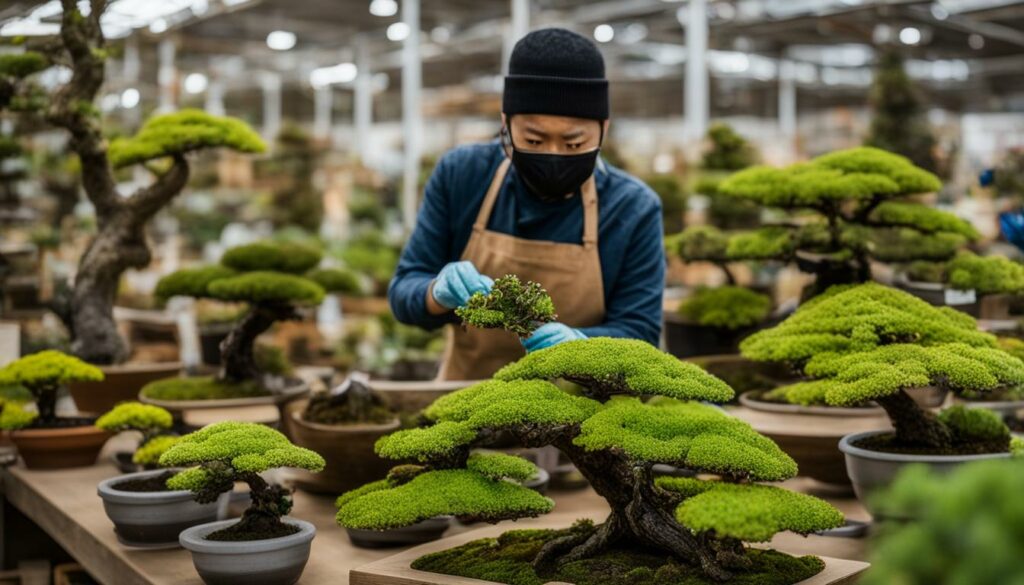
Regardless of which option you choose, carefully assess the advantages and considerations, and ensure that the bonsai tree aligns with your needs, preferences, and skills. Happy bonsai cultivating!
Evaluating Bonsai Quality
When buying a bonsai tree, assessing its quality is key to ensuring a healthy and long-lasting addition to your collection. Consider the following buying tips:
Root System
The root system is the foundation of a healthy bonsai tree. Check for a well-developed, compact root system that is well-distributed throughout the container. Avoid trees with root-bound systems or sparse, poorly-formed roots.
Branches
The branches of a bonsai tree should be evenly distributed and radiate from the trunk at different angles. Ensure that there are no crossing or duplicate branches, as this can lead to stress and damage over time.
Trunk Taper
The trunk of a bonsai tree should have a gradual taper that decreases in size from the base to the apex. Avoid trees with a thick or straight trunk, as this can indicate poor growing conditions or inadequate pruning.
“Assessing the quality of a bonsai tree requires a keen eye and careful consideration of its fundamental characteristics.”
Bonsai Tree Care Guide
Once you’ve chosen your perfect bonsai tree, it’s essential to understand how to take care of it properly. Here are some essential tips:
Watering
Watering your bonsai tree is crucial, but it can also be tricky. Over-watering or under-watering can cause damage. The key is to find the right balance. Check your bonsai’s soil daily and water only when the soil is dry. When watering, do it slowly and thoroughly to ensure the water reaches the roots. Use room temperature water and avoid chlorinated water, which can harm your bonsai.
Fertilization
Fertilization is essential to ensure your bonsai tree receives the necessary nutrients for growth and vitality. Use a balanced fertilizer every two weeks during the growing season and once a month during the dormant season.
Pruning
Pruning helps to shape your bonsai tree and control its size. Regular pruning also promotes new growth and keeps the tree healthy. Use sharp, clean scissors or shears and trim only a little at a time. Avoid trimming more than one-third of the foliage at a time.
Repotting
Like all plants, bonsai trees need space to grow. Repotting is a necessary step to give your bonsai room for healthy root development. Repot your bonsai tree every two to three years, or when the roots have outgrown their container.
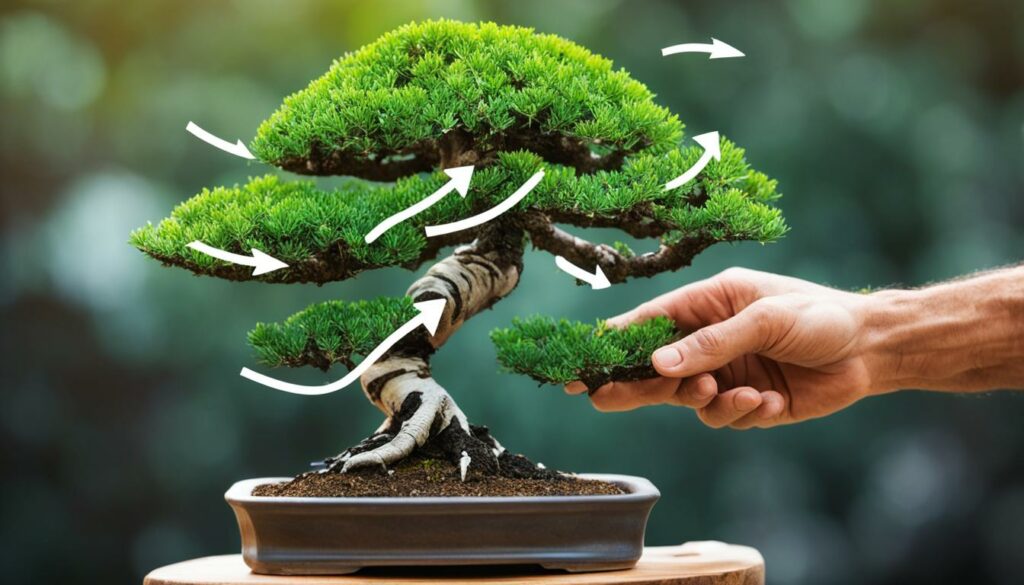
Proper bonsai care requires patience and persistence. Taking care of your bonsai tree is not an exact science, but more of an art in itself. Observe and understand your bonsai’s specific needs and make necessary adjustments to your care routine regularly.
Bonsai Tree Care Checklist
| Task | Frequency |
|---|---|
| Check soil moisture level | Every day |
| Watering | When soil is dry |
| Fertilization | Every 2 weeks (growing season), once a month (dormant season) |
| Pruning | When necessary, regularly |
| Repotting | Every 2-3 years or as needed |
With proper care, your bonsai tree can thrive and bring tranquility to your space.
Bonsai Tools and Accessories
Proper tools and equipment are essential for successful bonsai cultivation. The right tools will assist you in shaping and maintaining your bonsai tree, making the process easier and more efficient. Consider investing in the following essential tools:
| Tool | Description |
|---|---|
| Pruning Shears | Use for trimming foliage and small branches |
| Bonsai Scissors | Specially designed for precise trimming of twigs and leaves |
| Wire Cutters | Used for cutting and removing wire used in bonsai styling |
| Rake | Used for gently raking soil during repotting |
| Broom | Used for cleaning debris around the bonsai tree and work area |
Other useful accessories include concave cutters, branch benders, root hooks, and moisture meters. Keep in mind that quality tools and equipment can be expensive, but investing in them will save you money and frustration in the long run.
Remember to clean and maintain your tools regularly to ensure they perform well. Always choose high-quality tools that are sharp, comfortable to use, and appropriately sized for your hands. By equipping yourself with the right tools and accessories, you’ll be well-equipped to create and maintain a healthy, beautiful bonsai tree.
Bonsai Workshops and Classes
To become an expert in bonsai cultivation, you should take advantages of workshops and classes that provide more knowledge and refining your skills. Even if you already know how to care for your starter bonsai, there is always something new to learn that will help you expand your collection and take a more creative approach. Participating in local classes or online workshops can help you gain hands-on experience on bonsai styling, maintenance, and troubleshooting techniques while exchanging ideas with other enthusiasts.
Benefits of taking bonsai classes
Enrolling in bonsai workshops and classes can offer several benefits:
- Expand your knowledge of the bonsai world
- Learn new bonsai styling techniques
- Get hands-on experience with bonsai trees
- Connect with other bonsai enthusiasts and exchange ideas
Local Bonsai Workshops
You can search for your local nursery or botanical garden for bonsai workshops. They usually offer regular workshops and classes covering a wide range of topics, from beginner workshops that introduce the basic principles of bonsai cultivation to more advanced classes on styling, wiring, and customizing your bonsai tree.
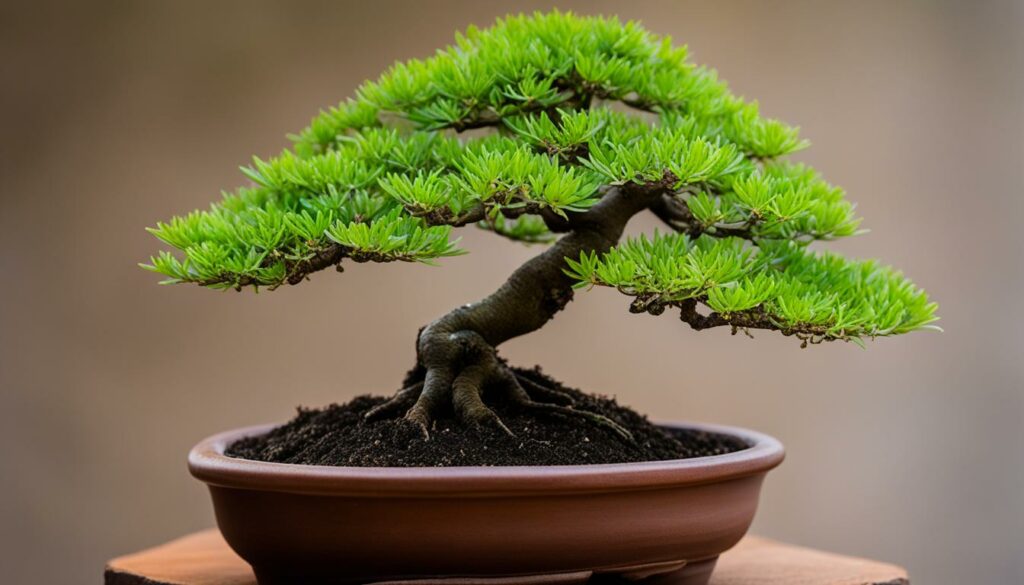
“Taking a local bonsai workshop was one of the best decisions I ever made as a bonsai enthusiast. Not only did I learn new techniques and concepts, but I also made friends with other bonsai lovers and expanded my horizons in ways I never could have imagined.” – Michael, bonsai enthusiast
Online Bonsai Courses
In addition to local workshops, several online resources can help you refine your bonsai skills and provide you with comprehensive knowledge about bonsai cultivation. Some online courses cater to beginners, while others offer specialized training on particular topics such as bonsai wiring and shaping, fertilization, and pest control.
Patience and Persistence: The Bonsai Journey
Starter bonsai trees require patience and persistence as they need nurturing and care to grow successfully. Cultivating bonsai trees is a journey that requires commitment and focus. Bonsai care is a long-term process, and it takes time to perfect. Every bonsai tree has its own unique personality and characteristics that need to be taken into account when choosing the right one for you.
“The bonsai tree is an art that involves dedication, patience, and attention to detail. The journey may be long, but the end result is a beautiful, miniature representation of nature that brings peace and serenity to any space.”
It is essential to understand that bonsai trees require time and dedication to blossom. To ensure your starter bonsai matures into a beautiful work of art, consistency in watering, pruning, and fertilizing is crucial. The journey of caring for a bonsai tree may present challenges, but persistence and determination will yield tremendous rewards.
In conclusion, the journey of cultivating a starter bonsai tree requires patience, focus, and perseverance. With consistent attention and dedication, your bonsai will blossom into a serene and stunning miniature representation of nature that will bring joy and peace into your life.
Showcasing Your Bonsai
Now that you have chosen the perfect starter bonsai tree, it’s time to showcase its unique beauty. Here are some creative ideas for displaying your bonsai both indoors and outdoors:
Indoor Displays
Displaying your bonsai indoors can add a touch of tranquility to any room. Consider these stylish ideas:
- Place your bonsai on a decorative stand or table in a well-lit area, away from direct sunlight.
- Create a display of multiple bonsai trees of varying sizes and styles to add interest and depth to a room.
- Showcase your bonsai as a centerpiece on a dining table or mantle, surrounded by complementary decor items.
- Hang your bonsai tree from the ceiling using a decorative hanger or macrame holder for a unique and eye-catching display.
Outdoor Displays
Displaying your bonsai tree outdoors can create a beautiful, serene atmosphere in your garden or patio. Consider these ideas:
- Place your bonsai on a decorative stand or table in a shaded area to protect it from harsh sunlight and outdoor elements.
- Create a miniature Japanese garden featuring your bonsai tree as the centerpiece, surrounded by rocks, moss, and other bonsai trees.
- Display your bonsai on a bench or shelf in a zen garden for a serene and minimalist look.
- Hang your bonsai from a tree branch or eave using a decorative plant hanger to create an eye-catching display.
Remember to rotate your bonsai periodically to ensure that all sides receive equal amounts of sunlight, helping it grow symmetrically.
You have put a lot of effort into selecting and nurturing your starter bonsai tree, now it’s time to showcase it and appreciate its unique beauty.
Troubleshooting Common Bonsai Issues
Even with the best care routines, it’s common to encounter issues with your starter bonsai. Familiarize yourself with these common problems and effective solutions to ensure the health and longevity of your tree.
Pests and Diseases
Identifying and treating pest infestations and diseases promptly is crucial to prevent damage to your bonsai tree. Common pests include spider mites, scales, and aphids. Diseases like root rot and powdery mildew can also occur.
In the case of pests, use insecticidal soap or neem oil to eradicate the infestation, and ensure proper ventilation and avoid overwatering to prevent reinfestation. To treat diseases, remove the affected foliage and switch to a well-draining soil mix to avoid waterlogging.
Improper Watering
Overwatering or underwatering can cause stress to your bonsai tree and lead to root rot or leaf wilt, respectively.
Ensure that the soil is moist but not waterlogged by checking the moisture level with your finger or a moisture meter. Water your starter bonsai thoroughly, allowing excess water to drain, but avoid leaving it sitting in a saucer of water. Watering frequency depends on various factors like species, climate, and size.
Incorrect Soil pH
The pH level of the soil can impact the nutrient uptake and overall health of your bonsai tree.
Choose a soil mix that is slightly acidic, with a pH range of 5.5 to 6.5 for most species. Test the soil pH regularly and adjust as necessary using lime or sulfur and avoid using tap water that may have a high pH level.
“Identifying and treating bonsai issues can be challenging, but with persistence and proper care, you can help your starter bonsai thrive.”
Expanding Your Bonsai Collection
Congratulations on successfully cultivating and maintaining your starter bonsai! Now that you have gained experience and confidence, it’s time to consider expanding your collection. The world of bonsai trees is vast and diverse, and there are countless species, styles, and techniques to explore. Your next bonsai purchase is a chance to deepen your appreciation for this ancient artform and continue your bonsai journey.
When looking for a new bonsai tree, consider your preferences and skill level. Do you want to try a new species or a different style? Are you ready to take on a more challenging tree that requires advanced techniques and care? Assessing your goals and capabilities will help you make a wise purchase decision that aligns with your needs and interests.
As with any bonsai purchase, evaluate the quality of the tree carefully. Check the root system, branches, and trunk for health and symmetry, and ensure that the tree is appropriate for your space and climate. If you’re buying from a local nursery or online marketplace, research the seller’s reputation and reviews to ensure a positive buying experience.
Where to Buy Bonsai Trees
As a seasoned bonsai enthusiast, you may already have a preferred source for purchasing bonsai trees. However, if you’re new to the bonsai community or want to explore different options, consider these sources:
- Local nurseries: A local nursery can offer a personalized touch and allow you to examine the tree in person before buying.
- Online marketplaces: Online marketplaces like Etsy and Amazon offer a wide selection of bonsai trees, often at competitive prices.
- Bonsai specialty stores: Bonsai specialty stores can offer expert advice and a vast selection of bonsai trees, but may be pricier than other options.
No matter where you choose to buy your bonsai tree, take your time and ensure that the tree meets your requirements and preferences. Remember, a bonsai tree is a long-term commitment and an investment in your wellbeing and aesthetic enjoyment.
Popular Bonsai Species to Expand Your Collection
| Bonsai Species | Origin | Difficulty Level |
|---|---|---|
| Chinese Elm | China, Japan, Korea | Easy |
| Japanese Maple | Japan, Korea, China, Mongolia, Russia | Advanced |
| Trident Maple | China, Japan, Korea, Mongolia | Intermediate |
| Bougainvillea | South America | Intermediate |
| Bald Cypress | North America | Intermediate |
As you explore new species, remember to research their specific care requirements and techniques. Consult expert resources and participate in bonsai workshops and classes to hone your skills and knowledge. Expanding your bonsai collection is an exciting opportunity to deepen your appreciation for this ancient artform and create a personalized, harmonious green space in your home or garden.
Conclusion
Now that you have a better understanding of bonsai cultivation and the factors to consider when buying a bonsai tree, you’re ready to embark on this serene journey. Remember to assess your lifestyle and available space, choose the right bonsai size, evaluate bonsai quality, and create a suitable care routine to ensure the health and beauty of your tree.
Consider enrolling in bonsai workshops or classes to enhance your knowledge and skills, and don’t forget to showcase your bonsai tree in a suitable location to highlight its unique beauty. With patience and persistence, you’ll be able to expand your bonsai collection and deepen your appreciation for this ancient artform.
Thank you for reading this buyer’s guide on Bonsai Cultivation Buying Bonsai. We hope you found the insights and tips provided useful in selecting the perfect bonsai tree that brings harmony and beauty to your surroundings. Happy bonsai cultivation!
FAQ
How do I choose the perfect bonsai tree?
Choosing the perfect bonsai tree involves evaluating your lifestyle and available space, considering factors such as sunlight exposure and temperature. It also includes selecting a bonsai tree species that aligns with your preferences and maintenance capabilities.
What are the different types of bonsai trees?
There is a variety of bonsai tree species available, including traditional Japanese varieties like Juniper and Pine, as well as tropical options like Ficus and Jade. Each species has its own characteristics and maintenance requirements.
What are some bonsai styling techniques?
Bonsai styling techniques include formal upright, cascade, and windswept, among others. These techniques influence the overall appearance and character of the bonsai tree.
How do I choose the right bonsai size?
The right bonsai size depends on your preferences, skills, and available space. It is essential to consider the level of maintenance and the visual impact you desire when choosing the size of your bonsai tree.
Where can I buy bonsai trees?
Bonsai trees can be purchased from local nurseries and online marketplaces. Each option has advantages and considerations, such as the ability to physically inspect the tree or the convenience of online shopping.
How can I assess the quality of a bonsai tree?
When assessing the quality of a bonsai tree, important factors to consider include a healthy root system, well-distributed branches, and proper trunk taper. These aspects indicate the overall health and potential of the bonsai tree.
What are the essential aspects of bonsai care?
Bonsai care involves watering, fertilization, pruning, and repotting. It is important to understand the specific requirements of your chosen bonsai species and create a suitable care routine accordingly.
What tools and accessories do I need for bonsai cultivation?
Essential tools and accessories for bonsai cultivation include pruning shears, wire cutters, bonsai soil, and watering cans. These items assist in shaping and maintaining your bonsai tree.
Are there bonsai workshops or classes available?
Yes, there are bonsai workshops and classes that provide guidance on bonsai techniques, styling, and care. You can find local courses or online resources to enhance your knowledge and skills in bonsai cultivation.
What should I do if my bonsai tree faces problems?
Troubleshooting common bonsai issues involves identifying and addressing problems such as pests, diseases, and improper watering. By learning how to tackle these issues effectively, you can ensure the health and vitality of your bonsai tree.
How can I expand my bonsai collection?
Once you have successfully cultivated and maintained your starter bonsai, you can consider expanding your collection by exploring new species, styles, and techniques. This allows you to continue your bonsai journey and deepen your appreciation for the artform.
